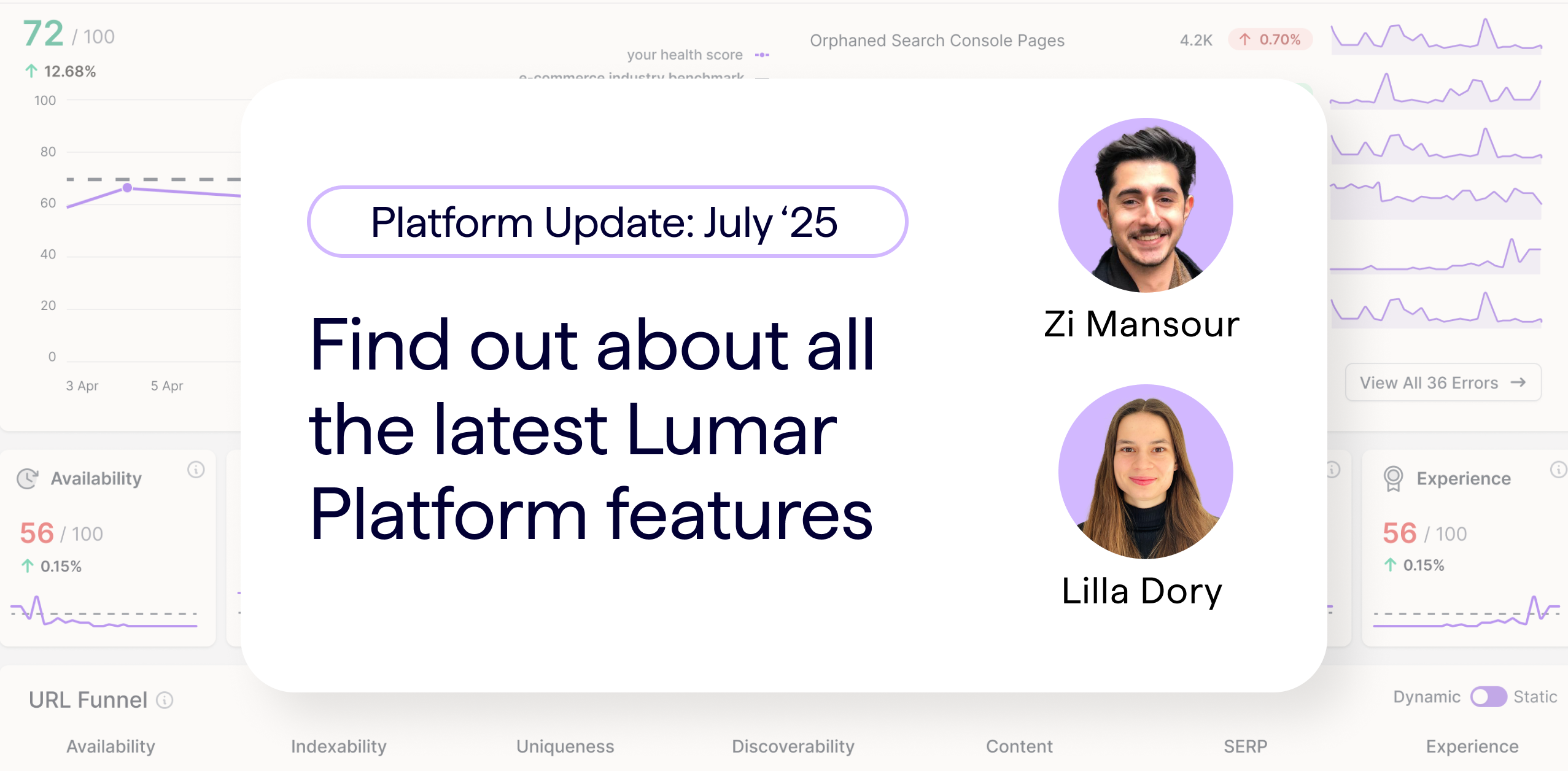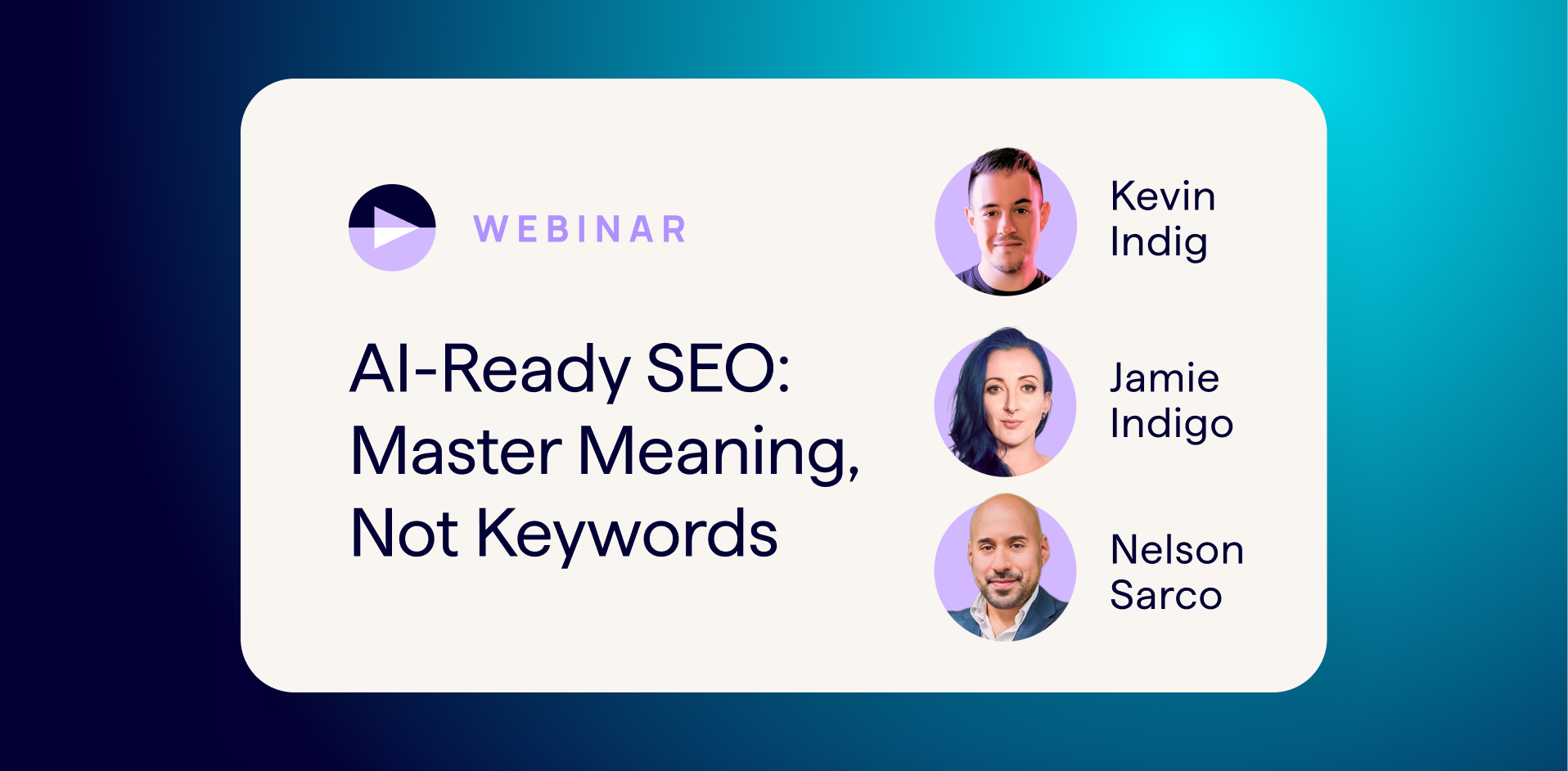Use these e-commerce SEO strategies to prepare your website for its peak sales seasons
Whether your peak sales season is summer travel, back-to-school shopping, or the winter holidays, now is a great time to get ahead of the curve on building out your best retail SEO strategies yet.
What you’ll learn in this e-commerce SEO webinar:
- Content and navigation changes to make — and not make — ahead of your key sales seasons.
- How to combat keyword cannibalization issues when your seasonal pages launch.
- How to perform SEO competitor analyses and pricing comparisons in the e-commerce space.
- How to leverage historic trends and search volume to plan your SEO campaigns.
- Conducting SERP landscape analyses and creating intent-driven content to match user queries.
Watch the entire webinar (including the audience Q&A session) above.
Want even more SEO insights on-demand? You can browse Lumar’s full library of SEO webinars here.

Meet the Webinar Speakers
- Richard Barrett, Director of SEO Pro Services, Lumar
- Jon Earnshaw, Chief Product Evangelist, Pi Datametrics
- Host: Pat Horridge, EMEA Sales Manager, Lumar
Join the webinar
Keyword cannibalization issues to watch out for during your peak sales seasons
Jon Earnshaw emphasized that keyword cannibalization is a more significant challenge today than ever—especially during peak sales seasons when e-commerce brands publish large volumes of new content. This surge often leads to internal competition between pages targeting similar queries.
How to handle keyword cannibalization:
- Identify It: Use performance data and rank tracking to spot URLs competing for the same keywords or terms.
- Fix It: This is often easier than expected—restructure internal links, consolidate content, or use canonical tags where needed.
- Prevent It: When creating new content, ensure it’s contextually distinct and supports a clear keyword strategy.
How much keyword cannibalization is acceptable on your website?
“A question I’m often asked is, how much [keyword] conflict is okay?” explains Earnshaw.
“It does actually depend — it depends on your competitors.”
“Here we have two businesses in the same space, so we’re comparing keyword cannibalization across 3,000 terms. One business has 41% cannibalization. Is that okay? Well, when your competitor’s only got 4%, I’d say it’s not okay.”
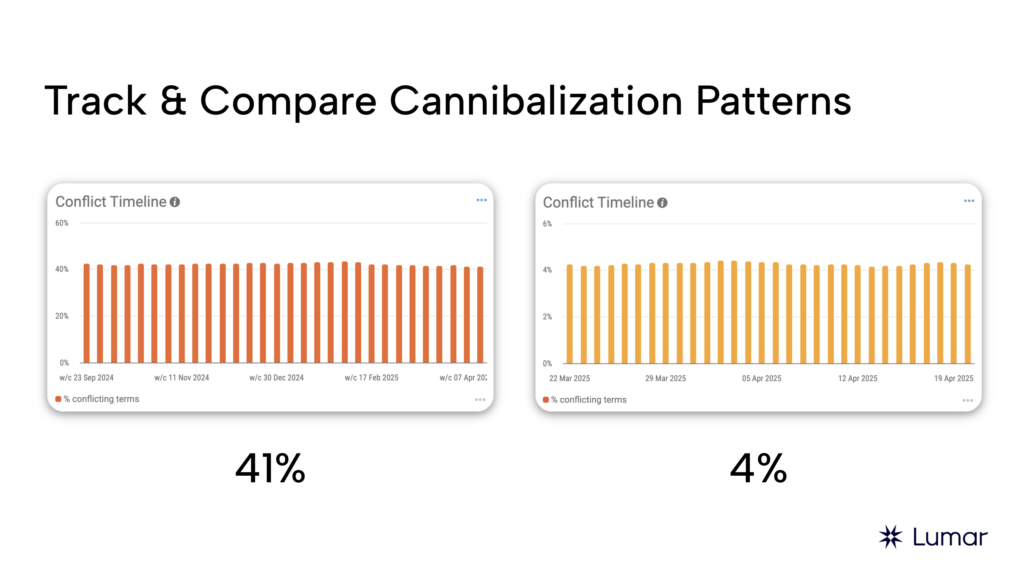
Monitoring and fixing keyword cannibalization on e-commerce websites
“One thing you have to be aware of with cannibalization, is that you have to know, is it staying the same? Is it is getting worse? Or is it getting better? As you can see in this chart here, we got about a 35 – 40% increase in the incidence of cannibalization, which, remember, is a keyword thing and not a content thing,” says Earnshaw.
“We often see this pattern [in keyword cannibalization growth] in the build-up to peak sales seasons, as everybody [leading up to Black Friday] thinks: content, content, content.”
“Everybody’s looking at the competition thinking ‘we’ve got to up our refresh rates and our content injection rates. And if this is happening to you, chances are you’re wasting effort.”
“You’re better off pulling that back, optimizing contextually, and reducing the amount of conflict.”
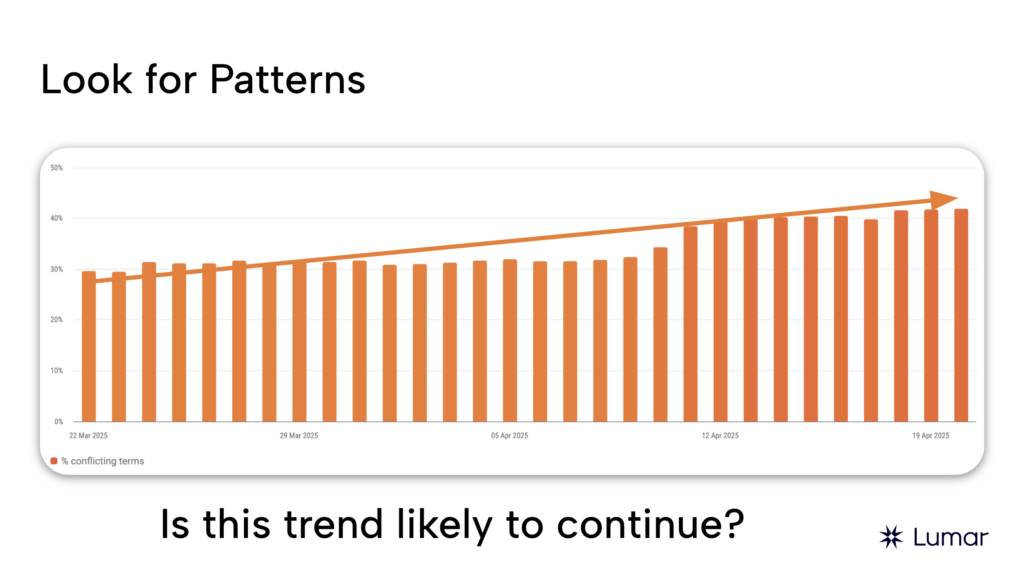
Keyword cannibalization on product pages — example fixes
Earnshaw provides an example of a male grooming product page on his client’s website that was seeing relative stability in the SERPs for months before keyword cannibalization issues caused it to drop in the rankings — and caused a drop in sales. He explains below how his team fixed the issue and regained the top spot in Google for this product page.
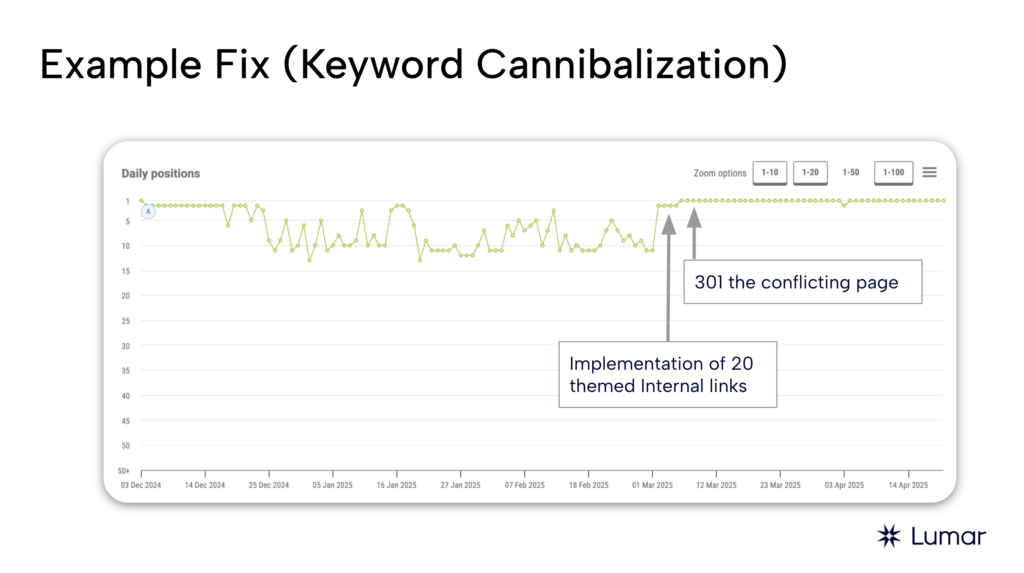
“I have a client who was trying to be position one for a particular product,” Earnshaw explains. They had position one back in December. Dropped to position two. Halved the revenue. Dropped further down. What was causing this?”
“Well, it turns out that there was another page [on their site] that had attracted a lot of authority because that was a sponsored page. That was causing this conflict.”
“So, the first step was identifying that it was [keyword] cannibalization. Secondly, which piece of content is causing it? Let’s try and fix it. Let’s channel authority by taking complementary pages and linking those — including the conflicting page — to the page that we want to position. That got us to position two.”
“But position two’s not enough — we can double our revenue for that particular item by moving to position one.”
“So we took the conflicting page and we asked a couple of questions. Is it generating revenue? No. Is it causing conflict? Yes. Is this page positioning in its own right? No. Do we really need it? No! Well, let’s redirect it.”
“And within 24 hours, that redirect actually resulted in a move to position one, where this product has stayed now for almost four weeks.”
Leveraging historic trends/search volume to plan your seasonal SEO campaigns
Earnshaw also advises e-commerce SEO professionals to use historical search volume trends to help plan their seasonal e-commerce and sales content and SEO campaigns.
“Even within a [single retail] category, you get different peaks [in search volume for different products],” explains Earnshaw.
“‘Garden furniture’ [as a search term] starts building on the 1st of January — [people are likely thinking] ‘New Year’s resolutions, let’s fix up the garden…’ and it builds all the way up into May, lasts for about a month, and then declines. So you know when you’re going to start [optimizing for those terms].”
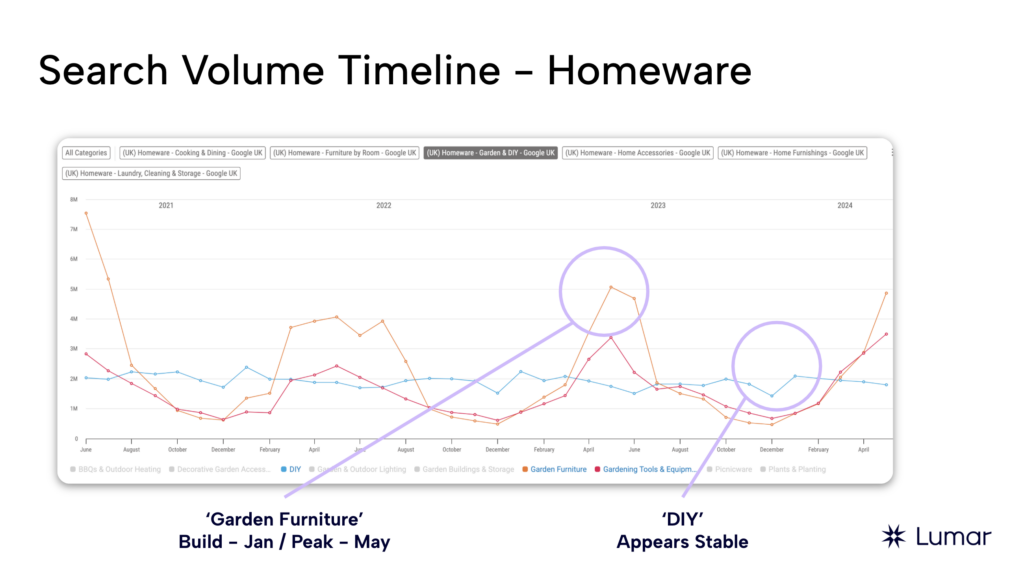
“I wouldn’t be producing content without looking at this data,” Earnshaw says.
“We see similar patterns in how Google will crawl pages,” adds Richard Barrett, head of Lumar’s SEO Professional Services team. “It will crawl more of a certain page, and you’ll see more errors appear if you’ve got errors within these sections at that time. So it’s mirrored in the sense of, what is happening on Google’s side is the same as what’s happening on the user side.”
SERP landscape analysis and intent-driven content
“What Google ranked in 2023 is not what Google wants to rank in 2025.”
“It’s not about the SEO that’s changed,” says Earnshaw, “It’s what you SEO.”
“So if you’re targeting your SEO efforts on the same things, assets, entities, that you were targeting in 2023, it’s not going to work in 2025.”
SEOs know that even one or two years can be quite a long time where Google is concerned.
“Anybody who’s been paying any attention whatsoever will be familiar with AI Overviews,” adds Barrett. “We know from the updates to the Quality Raters Guidelines [QRG], that [Google has] switched their focus on what is considered ‘quality’ [content].”
“What’s going to be considered ‘quality’ in the future is already changing. It’s already in limbo. Know that Google is always trying to keep up on the trends, on the data, about what people find useful,” Barrett says.
“Google’s also looking closely at how people search, what platforms they’re using, and where they are going,” says Earnshaw. “We are now seeing more social content [in Google SERPs].”
“There’s this need for fast content, firsthand, authentic, social, and also trusted,” he says, “And trust is critical for brand and business relationships.”
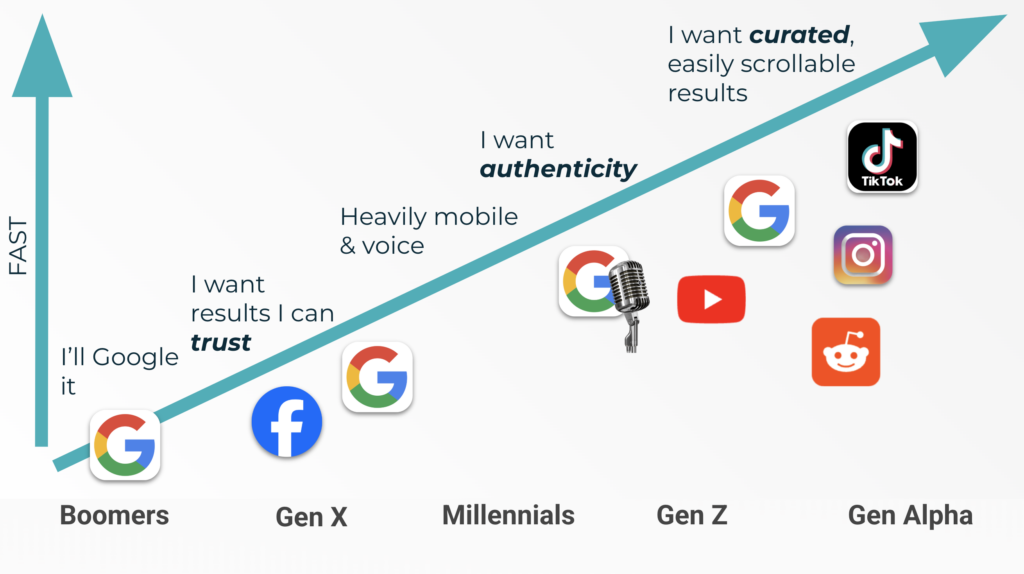
“As we go down the generations from boomers, Gen X, into Gen Alpha, people’s needs change and the search behavior changes radically,” says Earnshaw.
“And then we’ve got TikTok over there [in the top right],” he notes. “Authentic, curated content.”
“So, of course, Google’s thinking, ‘Well, we better get some of this into the SERP to replace the content that we eradicated as part of the spam update.”
“So you really have to start thinking about close alignment with social teams and social content,” advised Earnshaw.
“It wasn’t that long ago that Google announced that they were working closer with Reddit,” notes Barrett, “I’m not that big of a fan of that arrangement on Google’s side, but at least they’re being transparent… but that’s the state of search right now.”
Internal linking changes to support your seasonal sales
How we approach our internal linking structure is very important when it comes to seasonal sale pages and web content strategies overall.
Adding a new page whenever a sale comes along is often the go-to process for retail websites, but this can add to keyword cannibalization issues, as we’ve already discussed.
Instead of creating new pages every year, consider maintaining one page for sales that come around annually — so consider making your sale URLs more evergreen — ‘/mothers-day-sale/’ instead of ‘/2025-mothers-day-sale/’, for example. Or consider going even more generic with your prominently linked sales pages.
Barrett points to examples from two well-known e-commerce brands, Matalan and Costco, which both feature prominent sales pages on their websites.
Matalan currently has a Black Friday page on their site, even though it’s not November. Whereas Costco currently has a “Hot Buys” page in its website navigation. They are both relatively top-level pages. But Barrett notes how the more generic sales page approach on Costco makes more sense at this time of year than Matalan’s Black Friday page does. For Costco, “Hot Buys” is relevant to the site’s intent all year round.
“A lot of things can change from a single linking shift,” says Barrett. “Personally, I have done experiments where I have put a deeper page into the nav bar just to see what would happen, and the rankings have shot up.”
Avoiding soft 404s after a sale is done or product is out-of-stock
“I’ll move on to another one of my pet peeves for e-commerce companies,” says Barrett, “Soft 404s.”
“A ‘soft 404’ is a Google term,” says Barrett, “A soft 404 is a page that returns what is called a 200 status code, or, ‘everything’s fine, this is a real page’ — But then it has some content on there like ‘out of stock’ and Google says, ‘well, actually this should be a 404. So I’m going to treat it exactly like a 404.’ And that means all the negative stuff that is associated with a 404 happens anyway.”
“Now, it’s not necessarily the worst thing in the world,” he explains, “Each soft 404 is treated individually as a single page, it’s not something that affects the overall quality of your site unless you have an overwhelming number of soft 404s or 404s. But that’s what you’ve essentially done: you’ve created a 404 that you thought you’d sort of gotten around, perhaps.”
A fairly typical example of a soft 404 is an eBay listing that has been ended by the seller. Because the item is no longer available, Google now interprets that page as a ‘soft 404’ — ”So forget about any backlinks that pointed to that page, any internal authority, that’s all gone,” says Barrett.
But redirecting that page to content that says, “We’re sorry, the item you’re looking for is no longer available, but here are some similar items you may be interested in,” also was caught by Google and registered as a soft 404.
“Something to be keenly aware of: the language that you use on the page — particularly at the top of the page, or ‘above the fold’ — you’ve got to be careful that you’re not signalling to Google unintentionally that this page has no useful content on it,” says Barrett.
SEOs need to be wary of soft 404s when thinking about their seasonal pages and product pages that frequently go out of stock.
If you’re finding that these pages are not being displayed in the SERPs, perhaps because they are not seasonally relevant, soft 404s may be the reason. And it might be time to update the content on them or redirect them.
Preserving backlink gains after your sale season is done
If you’ve been building backlinks to your seasonal sales pages this year, what happens to all that ‘link juice’ and those authority-building signals for your site when the sale is over and your page is removed entirely, or removed from prominent internal linking positions?
“You’ve built your links to the Black Friday page or another sales page,” Barrett says. “But the page goes, it’s no longer part of the site. So [as an SEO, you think], I know what I’m going to do, I’ll redirect it and I’ll redirect it to my homepage and preserve all that value that has been built up…”
But Google may still mark this redirected URL as a soft 404 in this example situation. Then, all that value is gone.
“So many people do this,” adds Earnshaw, “They get lazy when it comes to redirects and redirect it too far up.”
“It’s a common problem with categories as well,” says Barrett, “They just redirect to the top category, which is kind of more related [than the home page] but there’s so much better that you could be doing there.”
“Another step down [in the site or category hierarchy for better relevance to the ended sale or out-of-stock product] could be to filter it to the same products, like redirecting out-of-stock red trainers to a filter for other red trainers,” he explains. “It’s a little bit better, but it’s not quite there, it’s not really what Google is after when it wants to get rid of pages that are out of stock, and it’s not quite what users want.”
“Think about how you can keep that page active on your site,” suggests Barrett, as an alternative to redirecting or fully removing the page after a sale is complete. He encourages e-commerce SEOs to become better curators of the content on their site.
SEOs need to ask themselves whether it is too much effort to add value to these out-of-date sales pages that Google may have crawled or discovered but that are not currently being indexed.
“Make good pages” is Barrett’s last takeaway on this. “And if it’s not a good page, maybe get rid of it,” he says.
How to conduct competitor pricing analysis ahead of your seasonal website campaigns
Barrett ends our e-commerce SEO session with an explanation of how you can perform competitive pricing analyses ahead of your seasonal sale campaigns, by either using the Lumar platform (and our custom web analytics features) or other tools.
Get the step-by-step process for competitor pricing analysis here:
Get the latest Lumar eBook: 2025 SEO Trends to Watch
Don’t miss the next Lumar webinar!
Sign up for our newsletter below to be alerted about upcoming webinars, or give us a follow on LinkedIn or Twitter/X to stay up-to-date with all the latest news in website optimization.
Want even more on-demand SEO webinars? Explore the full library of Lumar SEO webinar content.






